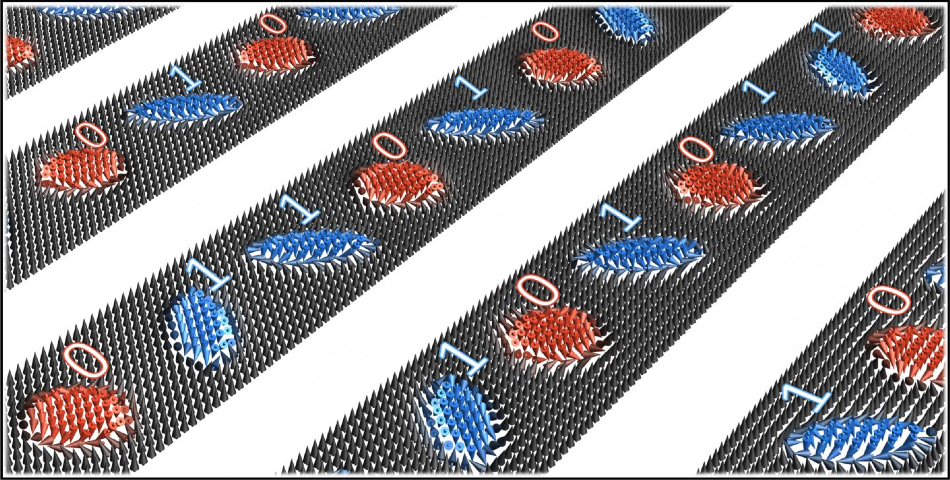Mar 4 2020
Magnetic (anti)skyrmions can be defined as very tiny whirls that are present in unique categories of magnetic materials. Nano-objects like these can be utilized to host digital data by their absence or presence in a series along a magnetic stripe.
 Schematic representation of the magnetization in an advanced racetrack memory data storage. Skyrmions (blue) and antiskyrmions (red) constitute the ‘1’ and ‘0’ bits, respectively. Image Credit: Dr Börge Göbel/ Martin Luther University Halle-Wittenberg.
Schematic representation of the magnetization in an advanced racetrack memory data storage. Skyrmions (blue) and antiskyrmions (red) constitute the ‘1’ and ‘0’ bits, respectively. Image Credit: Dr Börge Göbel/ Martin Luther University Halle-Wittenberg.
Now, a group of researchers from the Martin Luther University Halle-Wittenberg (MLU) and the Max Planck institutes (MPI) of Microstructure Physics in Halle and for Chemical Physics of Solids in Dresden has observed that antiskyrmions and skyrmions can exist together.
This discovery offers the possibility to expand the capabilities of skyrmions and antiskyrmions in storage devices. The study results were published in “Nature Communications”, a scientific journal.
The ever-growing volumes of digital data from the increasing numbers of devices have increased the need for data storage capacity significantly in the last few years.
However, traditional storage technologies are finding it difficult to keep pace with this demand. At the same time, these devices (random-access memories (RAM) and hard disk drives (HDD)) can increasingly consume a significant amount of energy, which does not correspond with a “green” energy landscape. Therefore, entirely new devices are needed that deliver more improved performance at a considerably reduced consumption of energy.
The magnetic racetrack memory-storage device offers a promising solution. It contains nanoscopic magnetic stripes, or the racetracks, where data is encoded within magnetic nano-objects, usually by their absence or presence at certain positions. A magnetic (anti)skyrmion is one potential nano-object. This is a highly stable whirl of magnetization with a size that can be changed from micrometers to nanometers.
Objects like these can be read, written and deleted, and, most significantly, moved by currents, thus enabling the racetrack to work without any kind of moving parts.
By stacking several racetracks, one on top of each other, to create an innately three-dimensional memory-storage device, the storage capacity can be drastically increased compared to solid-state drives and even hard disk drives. Moreover, such a racetrack memory device would operate at a fraction of the energy consumption of conventional storage devices. It would be much faster, and would be much more compact and reliable.
Stuart Parkin, Professor and Director, Microstructure Physics in Halle, Max Planck institutes
Parkin is also the Alexander von Humboldt Professor at the MLU.
Skyrmions and antiskyrmions are ‘opposite’ magnetic whirls. However, until recently, it was believed that these two distinct objects can only exist in different classes of materials.
Ingrid Mertig, Professor, Institute of Physics, Martin Luther University Halle-Wittenberg
Now, the team from the MLU and the Max Planck institutes in Halle and Dresden has found that both skyrmions and antiskyrmions can exist together under specific conditions in the same material.
Dr. Börge Göbel, a member of Mertig’s research group, offered the theoretical explanation for the surprising experimental observations performed by Jagannath Jena, who is part of Parkin’s team. Dr. Vivek Kumar, part of the group of Professor Claudia Felser at the MPI in Dresden, prepared the quantified single-crystal materials called Heusler compounds.
Both antiskyrmions and skyrmions are stabilized in varied materials by a magnetic interaction that is linked directly to the host material structure. Skyrmions can form only in certain materials, whereas in other materials, antiskyrmions are energetically required by this magnetic interaction.
But one fact that was overlooked in the past is that each separate magnet in each material (the “magnetic dipoles”) also interacts considerably with one another through their dipole-dipole interaction.
Such an interaction invariably prefers skyrmions. Due to this reason, even “antiskyrmion materials” can display skyrmions, but not the other way round. This interaction occurs preferably with decreasing temperatures. The two distinct objects exist together at a critical transition temperature.
Apart from its underlying significance, this discovery enables a sophisticated version of the racetrack memory data storage, in which a bit sequence can, for instance, perhaps be encoded by a series of antiskyrmions (‘0’ bit) and skyrmions (‘1’ bit). Such a concept would be more consistent when compared to traditional racetracks.